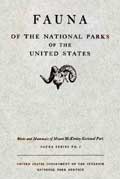.gif)
MENU
|
Fauna of the National Parks — No. 3
Birds and Mammals of Mount McKinley National Park |

|
Birds
DESCRIPTIONS OF BIRD SPECIES
BANK SWALLOW
Riparia riparia riparia [LINNAEUS]
GENERAL APPEARANCE.—A small swallow, dull brown above and white below with a distinct brown band across the breast. It has no irridescent green or blue on the back. Length, 5.2 inches.
IDENTIFICATION.—The rough-winged swallow is the only other species which is likely to be confused with the bank swallow. Both species nest in holes in clay or sandy banks. However, the bank swallows nest in colonies, while the rough-winged swallows nest in single pairs, or at most only a few pairs nest together.
As has been stated, a good field character for this bird is the narrow but distinct brown band across the breast. On the other hand, the whole throat and breast of the rough-winged swallow are gray.
DISTRIBUTION.—It breeds from Alaska and Quebec south to California, Arizona, Texas, Alabama, and Virginia.
HABITS.—This species is a common summer resident at low altitudes in the McKinley region. It nests in holes in banks usually overlooking a stream, pond, or small lake. Charles Sheldon (1930, p. 402) reports that the first spring arrival was noted May 18, at Toklat where it was a common breeding bird.
BARN SWALLOW
Hirundo erythrogaster [BODDAERT]
GENERAL APPEARANCE.—A large, graceful swallow with long deeply forked tail. This bird is dark steel blue above and rich reddish-chestnut below. The chestnut coloration is on the upper breast and throat. Length, 7 inches.
IDENTIFICATION.—Both the rich reddish under parts and the deeply forked tail are characters which will distinguish this species from all other swallows.
DISTRIBUTION.—It breeds from northwestern Alaska and Great Bear Lake south to Alabama and northern Mexico.
HABITS.—The first spring arrival of the barn swallow was noted by us on June 19, 1926, at Savage River. The bird was alone and was perched on a telephone wire near our cabin. In the spring of 1927, John and Paula Anderson reported that the first swallows reached Wonder Lake on June 10; and in 1929, the same observers state that the young barn swallows commenced to fly on July 10.
This species breeds in small numbers at Wonder Lake and in the Kantishna district of the McKinley region. Probably both the violet-green and the tree swallow will eventually be found breeding in the McKinley region.
NEXT >>>
 Top
Top
Last Modified: Thurs, Oct 4 2001 10:00:00 pm PDT
http://www.cr.nps.gov/history/online_books/fauna3/fauna9j3.htm
![]()
